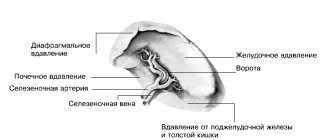The intrauterine device is installed for a period of 3 to 7 years and does not require monitoring by the patient. It is 99% effective, does not affect sex life and is safe during lactation.
Around 50 brands of IUDs are produced worldwide: round, oval and T-shaped, hormonal and non-hormonal, with silver or copper. Some set it for 2-3 years, while other manufacturers claim that their drug can be used for up to 7 years. How to choose the best drug for yourself? Let's figure out how they differ and which device is better.
The principle of operation of intrauterine devices.
Basically, the effect of the IUD is due to a mechanical obstacle to the passage of sperm.
In addition, under the influence of the hormonal IUD (Mirena), cervical mucus thickens and ovulation is suppressed. In some cases, fertilization still occurs, BUT in this case, the IUD prevents implantation.
The hormonal IUD can be used not only for contraception, but also for therapeutic purposes, for example, for endometriosis.
With the use of a hormonal IUD, menstruation becomes less abundant and may subsequently disappear completely. This is an expected reaction of the endometrium, and not a side effect. After the IUD is removed, the cycle is restored.
Cost of some services in our clinic
| Medical abortion MIROPRISTONE (appointment with a gynecologist, ultrasound included) | 4500 rub. |
| Medical abortion Mifepristone (appointment with a gynecologist, ultrasound included) | 6500 rub. |
| Medical abortion MIFEGIN (France) (appointment with a gynecologist, ultrasound included) | 9400 rub. |
| Gynecologist appointment | 1000 rub. |
| Appointment with a gynecologist-endocrinologist on contraception issues | 1500 rub. |
| Expert pelvic ultrasound (all organs) | 1200 rub. |
| Ultrasound of the uterus (for pregnancy) | 1000 rub. |
When is an IUD installed?
With a regular menstrual cycle, a copper-containing IUD is installed in the first 12 days after the start of menstrual bleeding, and a hormonal IUD in the first 7 days. In the case of a hormonal IUD, the contraceptive effect occurs 7 days after installation, so during these days it is necessary to use an additional method of contraception. After installing a copper-containing IUD, you can have open sex life from the moment of installation.
If the menstrual cycle is irregular, an IUD can be installed on any day, provided that the woman is definitely not pregnant! The IUD can be used during breastfeeding (4 or more weeks after birth).
Complications, side effects
The IUD does not cause the typical unpleasant symptoms caused by contraceptives. Women should not suffer from irritability, mood swings, water retention, weight gain or severe PMS symptoms. This is due to the fact that the IUD does not contain estrogen and does not cause hormonal disorders.
But, like any method of contraception, it has its drawbacks. These include:
- lack of protection against sexually transmitted diseases;
- cramps in the lower abdomen during menstruation;
- irregular menstruation (may even be absent);
- migraine.
How is an IUD installed?
Before installing an IUD, you must undergo the following examinations:
1. Ultrasound of the abdominal cavity and ultrasound of the breast
2. Tests for STIs
3. PAP TEST
The installation process itself takes about 20 minutes and takes place on the gynecological chair during the examination. The IUD is inserted into the uterine cavity, leaving control antennae in the vagina (for which the IUD is later removed). They will not cause you discomfort, BUT you need to be more careful when using tampons and removing them, since as a result of lightly tugging on the mustache, the spiral may shift and there will be no contraceptive effect.
The IUD can also be used by nulliparous girls, but there is a risk of the IUD falling out, since the uterus of nulliparous women is smaller.
Oksana Igorevna
MAKE AN APPOINTMENT
[contact-form-7 id=”296" title=”Untitled”]
Before having an abortion, a woman must make an appointment with a gynecologist.
An initial consultation is necessary to confirm the fact of pregnancy, accurately determine the period, size and place of attachment of the fetus.
Based on the results of the consultation, a decision is made regarding the possibility of terminating the pregnancy and the optimal method of abortion is determined.
THE COST OF AN ABORTION IN OUR CLINIC FROM 4500 rubles. THE PRICE INCLUDES PILLS, APPOINTMENT WITH A GYNECOLOGIST EXAMINATION, AN ULTRASOUND TO DETERMINE THE DATE OF PREGNANCY!
Advantages of contraception using the IUD.
- Long-term contraception: IUD is effective for 5 years
- Reliable method of contraception
- There is no need to monitor the regularity of taking pills, or the position of the patch or vaginal ring
- There are not as many side effects as when taking CHCs, including the IUD does not affect libido and does not increase the risk of thrombosis
- The hormonal IUD has a therapeutic effect in some gynecological pathologies (endometriosis, heavy menstruation, recurrent endometrial polyps)
- The IUD can be used during breastfeeding
- Quite an economical method of contraception
How it works?
The contraceptive device causes inflammation in the uterus, which makes fertilization impossible. The body begins to produce white blood cells that destroy sperm. Therefore, conception is impossible, pregnancy is impossible.
There are also hormone-releasing IUDs on the market that change the texture of cervical mucus, making it thicker, which is important for protection against pregnancy and infections. Therefore, the sperm loses its viability and moves more slowly.
The spirals are effective from the moment of “insertion” and remain fully effective for a long time, up to 5 years. Their advantage is that you can refuse them at any time and quickly return the body to its original state.
Disadvantages of using an intrauterine device.
- After installing the IUD, pain in the lower abdomen may persist for some time, 1-3 months. During this period, NSAIDs can be used.
- With a copper-containing IUD, menstruation may become more profuse, so much so that the IUD has to be removed.
- There is a risk of the spiral falling out or dislodging; this usually occurs within the first 3 months after installation. Therefore, if you feel that the IUD has fallen out or has shifted, consult a doctor immediately!
- Intermenstrual bleeding often appears, which causes inconvenience, but usually disappears in the first 2-3 months after installation.
- A common side effect during the first time after installation of a hormonal IUD is breast tenderness, headaches and slight weight gain.
- There are risks of pelvic inflammatory disease, so it is important to be screened for STIs before inserting an IUD. If you are concerned about persistent pain in the lower abdomen or pain during sexual intercourse, fever or abnormal discharge from the genital tract, then immediately contact your gynecologist.
- Although the IUD is a reliable method of contraception, BUT a low percentage of the probability of pregnancy still exists!
- It is extremely rare, but when installing an IUD, perforation of the uterus occurs - this is damage to the muscular layer of the uterus by the spiral! To avoid this situation, an OMT ultrasound and measurement of the length of the uterine cavity are performed before installation, and also after installation of the IUD, ultrasound control is necessary!
Birth control pills: advantages and disadvantages
Birth control pills (oral contraceptives) are the most common method of hormonal contraception.
Oral contraceptives use synthetic hormones that are similar in action to those produced by the body itself.
The composition of birth control pills must include the hormone gestagen , which provides protection against pregnancy.
Based on their composition, oral contraceptives are divided into:
- gestagenic (contain only the hormone gestagen)
- combined (contain two hormones: gestagen and estrogen (needed to control the menstrual cycle))
Principles of action of oral contraceptives
Birth control pills:
- suppress or inhibit ovulation
- affect the composition of the cervical mucus of the cervix, making it more viscous and thick, which prevents the passage of sperm into the uterus
- affects the endometrium (mucous lining) of the uterus so that a fertilized egg cannot implant in it
- progestin tablets additionally reduce the mobility of the fallopian tubes , which slows down the movement of the egg through them and, as a result, the likelihood that the sperm will have time to fertilize decreases
Benefits of birth control pills
- High degree of protection – up to 99% when used correctly
- It is possible to become pregnant in the next cycle after stopping oral contraceptives, but it is recommended to wait 3 months
- Can be used by nulliparous women
- Can be used to treat hormonal imbalances and some gynecological diseases
Disadvantages of birth control pills
Many disadvantages of oral contraceptives arise from their principle of action:
- mood swings
- nausea , sometimes vomiting
- breast tenderness
- weight gain (may be caused by fluid retention or changes in carbohydrate-fat metabolism)
- decreased libido
- worsening acne (quite rare)
- increased removal of microelements from the body . If there is a lack of microelements in the body, serious diseases can occur. When taking oral contraceptives, it is important to take vitamin complexes .
- deterioration in glucose absorption (rare)
- headache
- spotting (especially typical for oral contraceptives with one progestogen hormone)
- the hormone estrogen in combined birth control pills increases blood clotting (hypercoagulation), which leads to unpleasant consequences: the risk of thrombophlebitis, heart attack, stroke , and existing cardiovascular problems are aggravated.
- the need to take pills at the same time according to a strictly established schedule , otherwise the risk of becoming pregnant increases sharply
- To avoid negative consequences,
a gynecologist should
prescribe
birth control pills after conducting all the necessary studies
Depending on the type of gestagen (about a dozen different gestagens are used in pharmaceuticals) and on the presence or absence of estrogens (ethinyl estradiol is usually used) various side effects may be observed in oral contraceptives. The list of all side effects is indicated in the instructions for the tablets.
Contraindications to the use of birth control pills
- pregnancy
- presence of malignant tumors
- thrombosis or thromboembolism - the occurrence of blood clots in blood vessels
- previous heart attacks, strokes
- bleeding disorders
- cardiovascular diseases
- diabetes
- liver diseases
- smoking
- postpartum period less than 6 months
Conclusion
The use of birth control pills requires increased responsibility and self-organization, because the effectiveness of this method depends on the regularity of use.
The contraceptive effect does not occur immediately, but within a week after starting treatment.
Oral contraceptives affect hormonal levels, which leads to both simply unpleasant and dangerous side effects. However, they can be used in the treatment of certain gynecological diseases.
Intrauterine devices do not affect a woman’s hormonal background; their contraceptive effect is based on the physical properties of the components and appears immediately after installation.
Spontaneous loss of the IUD is possible, so it is necessary to check the presence of IUD threads in the vagina. It is also quite common to experience increased menstrual flow in the first months after installation. In addition, intrauterine devices increase the risk of developing inflammatory processes.
Both methods of contraception are highly effective.
The installation and removal of the IUD is carried out by a gynecologist. After some time, a re-examination is required, and if nothing worries you, further observation by a gynecologist is not necessary.
The selection and prescription of contraceptive pills should be carried out only by a gynecologist. Taking the wrong pills can lead to serious side effects. It is advisable to constantly monitor the condition of the body in order to promptly identify a lack of microelements or the development of concomitant diseases and correct their negative manifestations.
Contraindications to the installation of an IUD.
- Presence of a sexually transmitted infection
- Inflammatory processes of the pelvic organs (including in the postpartum period and the period after termination of pregnancy)
- Cervical cancer, uterine cancer, breast cancer
- Anomalies of the uterus - bicornuate uterus, septum in the uterine cavity
- Submucous uterine fibroids
- Uterine bleeding of unknown etiology
- Pregnancy
- Allergy to copper, Wilson-Konovalov disease - in the case of copper-containing IUDs
- Liver diseases and tumors, hypersensitivity to levonorgestrel - in the case of a hormonal IUD
Author: obstetrician-gynecologist Tarakanova M.Yu.
Rules to follow
Remember, such contraceptives cannot be installed before the onset of the first menstruation, and also for mature ladies after 50 years.
Before the procedure, you should definitely take a smear for flora and infections, and cytology. Make sure that there is no pregnancy at the time of installation of the intrauterine device; to do this, it is enough to undergo an ultrasound examination of the pelvic organs; if in doubt, an additional hCG blood test.
Avoid sexually transmitted infections and use condoms when changing partners frequently. Understand that even ordinary pathogens behave extremely aggressively in the presence of the IUD and can provoke serious inflammation of the fallopian tubes and uterus.
The University Clinic offers a free consultation with a competent gynecologist online, an appointment with a specialist at a convenient time, a comprehensive examination, and a safe installation or replacement of an intrauterine device.
Classification
There are 2 groups of spirals:
- hormonal;
- non-hormonal.
Both perform the same task - protection from unwanted pregnancy. But some of them have additional properties. For example, hormonal IUDs are often used in gynecological practice as a way to treat certain diseases, and non-hormonal IUDs with the addition of silver or gold have a bactericidal effect and protect the female reproductive system from unwanted infections.
There are 3 generations of spirals:
1st generation
- An IUD without any metal or hormone, consisting only of medical grade plastic.
- Their contraceptive effect is achieved only through the mechanical impossibility of attaching the fertilized egg to the endometrium.
- Often cause complications (infectious diseases, ectopic pregnancy and prolapse of the IUD - expulsion).
1st generation IUDs are no longer used because more reliable and effective IUDs exist.
2nd generation
- IUDs containing metal. That is, these are spirals that also consist of medical plastic, but have a contraceptive effect due to additional components - copper, silver, gold.
- Metals act not only on the female body, but also on the male factor - sperm, and thereby reduce the risk of unplanned pregnancy.
3rd generation
- Hormonal IUDs, which at this stage are used as therapeutic and contraceptive agents.
Intrauterine devices have different shapes:
- T-shaped;
- round or semicircular;
- in the form of an umbrella;
- horseshoe-shaped (semi-oval).
Each spiral has its own advantages and disadvantages and is selected individually depending on the characteristics of a particular woman’s body.
All IUDs have the same operating principle – protection against unwanted pregnancy.
Removal of the Mirena IUD
The IUD is removed after its expiration date or prematurely if a woman desires to become pregnant. In this case, the gynecologist uses special threads, which makes this process quick and painless. After removal, the spiral must be shown to the woman to confirm the fact of extraction.
After removal of the IUD, the menstrual cycle is usually restored within the next 2-3 months. After this period, the woman can plan a pregnancy.









